Coyotes can be a serious problem for homeowners, farmers, and agricultural producers. These intelligent predators prey on livestock like chickens and sheep, and often raid yards and trash cans in search of food. If you’re facing a coyote problem on your property, this guide will show you the most effective and humane ways how to get rid of coyotes.
Quick Picks: How to Get Rid of Coyotes
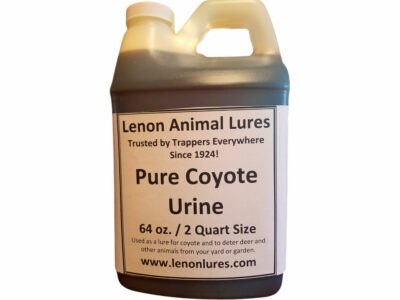
Best Repellent
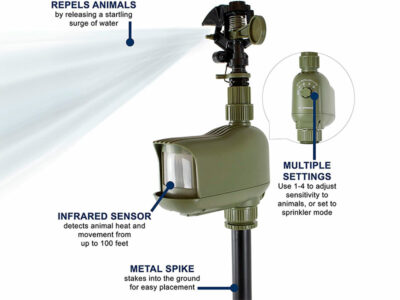
Best Deterrent
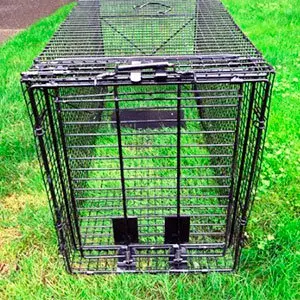
Best Trap
Understanding Coyote Behavior and Problems
Coyotes can be found throughout the United States. About 90% of a coyote’s diet consists of animal matter, though they also feed on various fruits like blueberries, peaches, apples, and persimmons. When their feeding leads them to yards, livestock, or pets, they become a serious problem for property owners.
Their damage is quick and complete. Coyotes readily eat chicken, pheasant, and turkey. They consume eggs, causing significant financial losses to both hobby and commercial farmers. Fish or turtle ponds on your property can also provide a quick meal for these predators.
Coyotes are intelligent, adaptable predators that can be found almost anywhere. Their intelligence makes them difficult to control, but it also makes them vulnerable to properly implemented control methods.
5 Steps to Get Rid of Coyotes Humanely
Getting rid of coyotes is challenging but possible. These five steps will help you maintain a coyote-free property in a humane way.
1. Stop Feeding Them
Coyotes have a varied diet and will eat virtually anything: rodents, fruit, vegetables, insects, and more. The first step to getting rid of coyotes is removing food attractants from your yard.
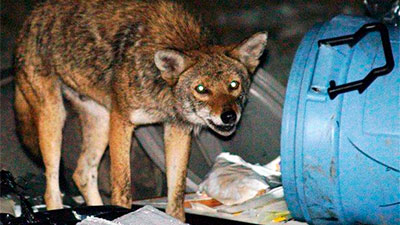
Dispose of garbage properly by keeping it in your garage until trash day. Pick up fallen fruit from trees and gardens. Keep pet food indoors and feed pets inside. Make sure garage doors are closed at night to prevent access to garbage cans.
Food-insecure coyotes can be more dangerous as they become desperate and venture closer to residential areas in search of food. Taking away food sources is essential but must be done consistently.
2. Install Proper Fencing
Although fencing can change your landscape, it’s often an effective solution to keep coyotes out. Coyotes can jump over 6 feet high and use their front paws as shovels to dig under barriers.

For best results:
- Fences should be at least 8 feet tall
- Extend fencing at least 12 inches underground
- Consider installing roller bars on top of the fence
- Electric fencing works best on flat terrain with no trees nearby
For added protection, put livestock in a barn before dusk.
3. Use Urine Repellents
Coyotes are territorial animals, and they will typically avoid areas where they detect the scent of other coyotes. Urine repellents leverage this instinctual behavior.
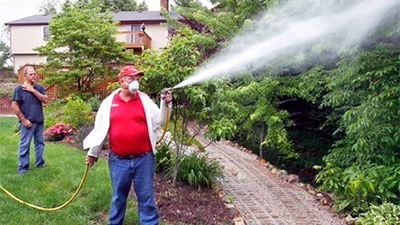
Where to Apply Urine Repellents:
- On trees with large footprints
- At all access points where coyotes might enter your yard
- Near natural water sources (streams, creeks, ponds)
Other effective urine-based repellents include:
- Wolf urine (coyotes fear wolves)
- Mountain lion urine
- Various commercial predator urine products
Coyote Pure Urine by Lenon Animal Lures
Coyote Pure Urine contains 100% urine collected from live animals in the wild. Available in a 4 oz. spray bottle and a 1-gallon size, it can be used as a fogging agent or general deterrent for all types of coyote issues. The urine leverages coyotes’ territorial nature – they typically avoid areas marked by other coyotes.
The product is guaranteed for 30 days after first use, so apply generously and spray often for best results. Apply to trees with large footprints, access points, and near natural water sources.
4. Install Motion-Activated Devices
Motion-activated sprinklers are excellent deterrents for coyotes trying to enter your property. When they detect movement, these devices spray water, startling and deterring the animals.
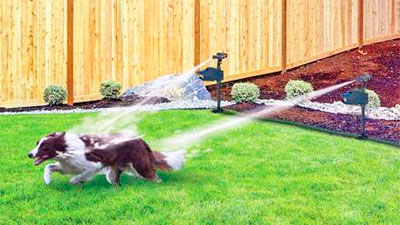
Havahart Motion-Activated Animal Repellent & Sprinkler
The Havahart Motion-Activated Sprinkler detects movement up to 100 feet away and releases a 5-second burst of water to startle and deter coyotes and other unwanted wildlife. It’s easy to install with no wiring required and can be set up in minutes.
This system is ideal for yards without an existing water source and can be used on front steps, backyard decks, garages, mailboxes, tree lines, and more. The combination of sudden water spray and unexpected noise creates an effective deterrent that conditions coyotes to avoid your property.
5. Maintain Your Property
Keep your backyard well-maintained with trimmed bushes and short grass. This eliminates hiding spots and makes your property less inviting to coyotes.
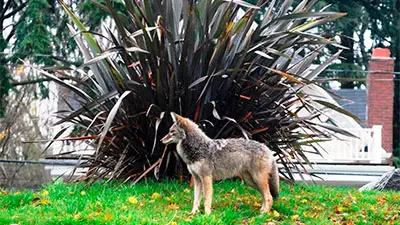
Keep your backyard very maintained. Make sure your bushes are trimmed and your grass is cut short. This takes away predators’ opportunities for shelter.
Additional ways to make your property less inviting:
- Don’t leave food out at night
- Remove brush piles from around your yard
- Keep pets and livestock in secure enclosures, especially at dawn and dusk
- Keep garbage cans in a garage or enclosed area
- Remove bird feeders that attract rodents (which attract coyotes)
- Plant thorny bushes around your property perimeter
- Install motion sensors with bright lights
- Keep garage and shed doors closed
Effective Coyote Trapping Methods
If preventive measures aren’t enough, live trapping may be necessary. When setting up a trap, locate an area with coyote activity, camouflage the trap with natural foliage, and use appropriate bait.
Using coyote urine sprinkled on the edge of the trap can help lure these animals inside. Effective bait options include meat, fish, or eggs.
Human Trap by Humaneway
The Human Trap by Humaneway offers the easiest way to catch coyotes without causing them harm. The trap features handles on both ends which make it easier to lift and transport after capturing an animal.
This humane trap is ideal for situations where you need to relocate coyotes rather than harm them. When using this trap, place it in an area with known coyote activity and camouflage it with natural foliage. Bait with meat, fish, or eggs, and consider adding coyote urine around the edges to increase effectiveness. Ensure that the trap is checked regularly to prevent undue stress or harm to the captured animal. Additionally, while this trap is specifically designed for coyotes, it’s worth noting that some of the best humane cat traps can also be effective in capturing smaller wildlife if needed. Always follow local regulations regarding the trapping and relocation of wildlife to ensure a safe and compliant process.
| Trap Type | Features | Price Range |
|---|---|---|
| Havahart X-large One Door Trap | Largest trap for humane capture of big animals | ~$100 |
| Human Trap by Humaneway | Handles on both ends for easier lifting and transport | ~$165 |
| Imperial Pro Series Large Animal Trap | Extra carry handles, double trap locks, heavy steel frame | ~$170 |
| Coil Spring Trap | Foot-hold restraining device, efficient for coyote management | Varies |
Effective Coyote Lures
To increase trapping success, consider these commercial lures:
- Coyote Juice by Wildlife Research – High-quality coyote calling scent
- Coyote Trapping Lure by Pete Rickard’s – 100% pure lure that works all season
Best Coyote Deterrent Products
Keeping coyotes away from your property requires a multi-faceted approach. Here are some effective commercial deterrents:
Nite Guard Solar
Solar-powered flashing lights that coyotes perceive as predator eyes at night. Helps protect pets, poultry, and livestock from coyote attacks.
Spray Away Elite II
Solar-powered motion-activated sprinkler that can effectively repel coyotes and protect any part of your property.
Predator Urine Products
P-Cover Wolf Urine Granules, Timber Wolf Urine, and Mountain Lion Urine are all excellent options for deterring coyotes through natural fear responses.
When Lethal Control Is Necessary
Sometimes, when humane methods aren’t effective, lethal control may be necessary. No single method is universally best—different situations call for different approaches.
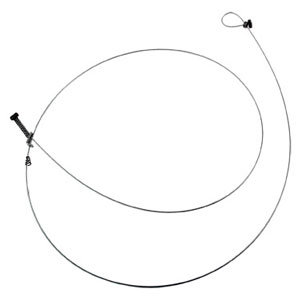
Snare
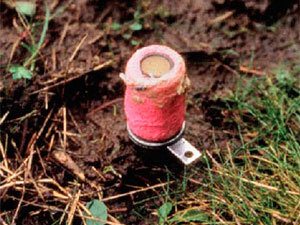
m-44
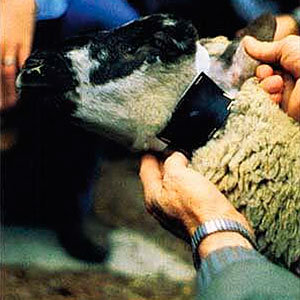
Livestock Protection Collar
Lethal control options include:
- Snares – Relatively economical and cost-effective, requiring less skill than traps
- Leghold Traps – Used on trails or at fence crossings, though they may catch livestock in some areas
- M-44 Devices – Require special licensing and training to use legally
- Calling and Shooting – Various calls to attract coyotes; requires shooting skill
- Livestock Protection Collars – Applied to vulnerable livestock; contains toxicants that affect predators during an attack
Frequently Asked Questions
Will lights keep coyotes away?
Yes, coyotes tend to avoid well-lit areas because they perceive light as dangerous. Motion-activated lights are particularly effective as they suddenly illuminate the area when coyotes approach, startling them away.
When combined with other deterrents like motion-activated sprinklers, lights can significantly reduce coyote activity around your property.
Can dogs sense coyotes?
Yes, dogs can typically detect coyotes from a distance. They have a much stronger sense of smell than humans and can pick up coyote scents even from far away.
Your dog’s increased alertness or unusual behavior might indicate coyote presence in the area. However, never rely solely on your dog for coyote detection, as this could put your pet at risk.
Can coyotes jump fences?
Yes, coyotes can jump fences up to 6 feet high. They can also climb over fences and walls by jumping and using their back feet as leverage.
For fences five feet or higher, installing a roller bar on top can help prevent coyotes from gaining access to your property. Extending the fence underground by at least 12 inches can also prevent digging.
What time of day are coyotes most active?
Coyotes are typically most active at dawn and dusk (crepuscular behavior), though they can be active at any time of day or night.
In urban and suburban areas, coyotes often become more nocturnal to avoid human activity. Take extra precautions with pets and livestock during these peak activity times.
Are coyotes dangerous to humans?
Coyote attacks on humans are extremely rare. Coyotes are naturally afraid of humans and will typically avoid contact whenever possible.
However, coyotes that have been fed by humans may lose their fear and become more bold. Never feed coyotes, and always maintain a safe distance if you encounter one.
What should I do if I encounter a coyote?
If you encounter a coyote:
- Make yourself appear larger by raising your arms or opening your jacket
- Make loud noises by shouting, clapping, or using an air horn
- Maintain eye contact and back away slowly
- Never run from a coyote as this may trigger a chase response
- Throw objects near (not at) the coyote to scare it away
This “hazing” behavior helps reinforce coyotes’ natural fear of humans.
How can I protect my small pets from coyotes?
To protect small pets from coyotes:
- Never leave small pets outside unattended, especially at dawn or dusk
- Keep cats indoors, particularly at night
- Use a 6-foot leash when walking dogs in areas with known coyote activity
- Install proper fencing with roller bars and underground extensions
- Consider a coyote-proof enclosure for outdoor pets
- Remove food sources that might attract coyotes to your yard
Do coyotes hunt in packs?
While coyotes sometimes hunt in family groups during winter when taking down larger prey, they typically hunt alone or in pairs. The “packs” that people report seeing are usually family groups consisting of a mated pair and their offspring.
Unlike wolves, coyotes don’t form large, coordinated hunting packs. Each coyote family usually maintains a specific territory that they defend against other coyotes.
What attracts coyotes to residential areas?
Coyotes are attracted to residential areas by:
- Food sources like pet food, unsecured garbage, fallen fruit, and small animals
- Water sources such as pools, ponds, and pet water bowls
- Shelter opportunities in dense vegetation, abandoned structures, or under decks
- Potential prey like rodents, rabbits, and unfortunately, small pets
- Reduced human activity (especially at night)
Eliminating these attractants is key to keeping coyotes away from your property.
Is it legal to kill or trap coyotes?
Laws regarding coyote control vary significantly by location. In many areas, coyotes are considered game animals or nuisance wildlife, with specific regulations governing when and how they can be trapped or hunted.
Always check with your local wildlife management agency or animal control department before attempting any lethal control methods. In many urban and suburban areas, non-lethal management is the only legal option.
